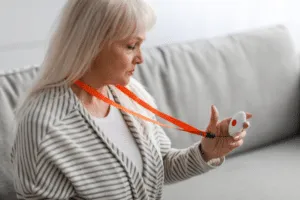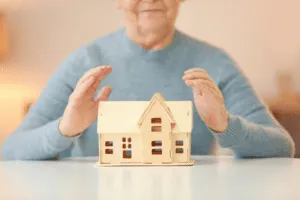When it comes to the safety and well-being of elderly loved ones, home is often where they feel most comfortable and independent. However, as seniors age, their living environment can present certain challenges that may put them at risk of accidents. Ensuring that your loved one’s home is safe is a vital part of maintaining their health and happiness as they age. At Nurse Next Door, we recognize that home safety goes beyond simple precautions—it’s about creating an environment where seniors can thrive, feel secure, and continue to live independently. By tailoring safety measures to fit the specific needs of each individual, we help seniors not only stay safe but also enjoy a higher quality of life.
Identifying and Addressing Common Home Hazards
The first step in making a home safe for an elderly person is to identify potential hazards. Many accidents in the home can be prevented with simple changes. Some of the most common risks include falls, poor lighting, and clutter. Here’s how you can address these and other potential hazards:

- Secure Rugs and Clear Clutter: Loose rugs and cluttered floors are major tripping hazards. Fasten down throw rugs with non-slip pads and make sure pathways are free of furniture, electrical cords, and other obstacles.
- Enhance Lighting: Poor lighting can increase the risk of falls and make it harder for seniors to move around the house. Install bright, easily accessible lighting in hallways, bathrooms, and bedrooms to improve visibility, especially at night.
- Manage Cords Safely: Electrical cords should be kept out of walkways to avoid tripping. Use cord clips or organizers to keep cords tidy and out of sight.
- Install Smoke and Carbon Monoxide Detectors: Ensure that smoke alarms and carbon monoxide detectors are installed on every floor and outside bedrooms. Regularly test the batteries to ensure they’re functioning properly.
- Fire Safety: Keep a fire extinguisher in the kitchen and make sure everyone in the household knows how to use it. Regularly check that it is in good working order.
- Security Systems: A home security system can provide peace of mind for families, offering alerts on potential threats or intrusions. This added layer of security can be invaluable, especially if the elderly person is living alone.
Key Areas of the Home to Focus On
Each area of the home requires special attention to ensure the safety of elderly residents. By focusing on these key spaces, you can significantly reduce the risk of accidents and help your loved ones live comfortably and independently.
Bathroom Safety: Preventing Slips and Falls
The bathroom is one of the most hazardous rooms in the home for seniors due to wet, slippery surfaces. Here’s how you can improve bathroom safety:
- Install Grab Bars: Place grab bars near the toilet, shower, and bathtub. These simple additions provide extra support and stability when moving around in the bathroom.
- Non-Slip Bath Mats: Use non-slip mats in the bathtub or shower to prevent falls. A slip-resistant mat outside the shower is also a good idea to absorb water and reduce the risk of slipping.
- Adjust Water Temperature: To prevent burns, set the water heater to 120°F (49°C) or lower. This will help protect sensitive skin from scalding water.
- Raised Toilet Seats: These make it easier to sit and stand, reducing the strain on joints and muscles, which is particularly helpful for those with mobility issues.

Kitchen Caution: Safe Cooking and Food Storage
The kitchen is another area where seniors need special attention. Taking a few precautions can help prevent accidents in this space:
- Store Harmful Chemicals Safely: Keep cleaning products and other hazardous materials out of reach, preferably in locked cabinets, to avoid accidental ingestion or exposure.
- Automatic Shut-off Appliances: Use appliances with an automatic shut-off feature to prevent the risk of fire caused by unattended cooking.
- Keep a Cordless Phone Nearby: In case of an emergency, ensure that a phone is easily accessible. A cordless phone or cell phone should be within reach so your loved one can call for help if needed.
Living Room and Bedroom: Minimizing Fall Risks
The living room and bedroom are where seniors often spend a lot of time, making safety in these areas crucial:
- Rearrange Furniture: Move furniture to create clear paths and remove any tripping hazards. Avoid placing unnecessary items in walkways.
- Install Bed Rail Guards: These are particularly helpful for seniors who have difficulty getting in and out of bed. They can also prevent falls from bed during the night.
- Non-Slip Footwear: Encourage your loved one to wear shoes or non-slip socks, especially on hard floors, to reduce the risk of slips.
- Strobe Lights or Vibration Alarms: For seniors with hearing impairments, strobe lights or vibration alarms can alert them to important safety signals, such as fire alarms or emergency notifications.
Emergency Preparedness: Be Ready for the Unexpected
A well-prepared household is key to responding quickly in an emergency. Take the following steps to ensure your elderly loved one is ready for any unforeseen situation:
- Emergency Contact List: Keep a list of emergency contacts, including doctors, caregivers, and family members, posted in an easily visible location.
- Evacuation Plan: Make sure your loved one understands the evacuation plan in case of a fire or other emergency. Practice the plan regularly so everyone knows what to do.
- First Aid Kit: Keep a basic first aid kit in the home, stocked with essentials such as bandages, antiseptics, and medications. Make sure it’s easily accessible in case of injury.

Embracing Technology for Added Safety and Peace of Mind
Technology can play a vital role in enhancing the safety and security of elderly individuals. Smart home devices and medical alert systems are invaluable tools that provide both seniors and their families with peace of mind.
- Medical Alert Systems: Devices like Life Alert or MobileHelp can detect falls and instantly notify emergency contacts or services. Some systems even offer GPS tracking, which is helpful if your loved one has dementia or gets lost.
- Smart Home Devices: Voice-activated assistants like Amazon Echo or Google Nest can help seniors control their environment more easily, from adjusting the temperature to turning on lights. These devices also provide hands-free communication, which can be crucial in an emergency.
- Remote Monitoring Systems: Tools like video cameras and motion sensors allow family members to monitor their loved one’s safety remotely. This can be particularly helpful for caregivers who cannot be physically present but want to ensure their loved one is safe.
Engaging Family Members in the Safety Process
Creating a safe home environment is a team effort, and family involvement is essential. Regular safety assessments and communication with your elderly loved one about their needs and preferences can lead to better care and improved safety measures.
- Family Safety Meetings: Organize regular meetings with family members to discuss safety improvements, review emergency plans, and update contact information.
- Involve Seniors in Decision Making: Whenever possible, include your elderly loved one in decisions about their care and home safety. This respects their autonomy and empowers them to take an active role in their well-being.
Conclusion: A Holistic Approach to Senior Safety
At Nurse Next Door, we believe that safety goes beyond preventing accidents. It’s about fostering an environment where seniors can live with dignity, independence, and joy. By implementing practical safety measures, embracing technology, and engaging family members, we can help our elderly loved ones enjoy their homes for years to come. Each step you take toward improving their environment contributes not just to their physical safety but to their emotional and mental well-being as well. Together, we can ensure that the golden years are lived in comfort and security.



